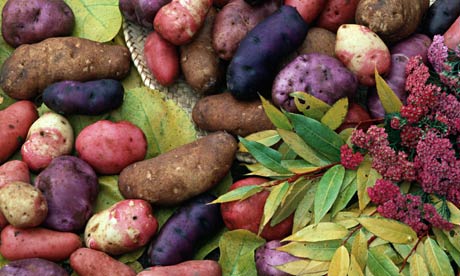You may not be familiar with scarlet, purple or knobbly potatoes, but thanks to the current revival in tasty heritage varieties, you soon will be. You could even try growing your own, says Norman Miller
Read the full article here: Norman Miller on the revival of the not so humble potato | Life and style | The Guardian.

or on this site below:
There’s little more comforting than freshly mashed potato with butter and black pepper – even if it is mauve. But before anyone starts muttering about Frankenstein crops, this is agricultural history on a plate.
The salad blue behind my mash – though more purple than blue – is one of a growing number of heritage potato varieties enjoying a renaissance. Their names are as enticing as their taste and appearance – dunbar rover, epicure, mr little’s yetholm gypsy, pink fir apple. Many of these species were widespread in Britain until, after the second world war, a country desperately short of food pushed farmers towards producing higher-yielding but bland varieties such as the maris piper that still dominate the market. “Things like flavour and texture weren’t selected for – they were just trying to keep the population alive,” says Anthony Carroll of Carroll’s Heritage Potatoes, winner of the Producer of the Year gong at the 2009 Observer Food Monthly Awards. Lucy and Anthony Carroll grow more than 20 different varieties at Tiptoe Farm in Northumberland’s Till Valley, and are at the forefront of the revival, supplying culinary shrines such as Le Gavroche in London.
Potatoes have a far richer diversity than the average supermarket shelf suggests. There are 5,000 varieties worldwide, though 3,000 are found only in the Andes where a single valley may contain 100 different types. Only a handful of species were introduced to Europe in the 16th-century and from those, dedicated potato growers in the 19th and early 20th centuries bred many of the heritage gems that are again becoming popular. In 1897, for example, the epicure was created in Hampshire, 1899 saw the introduction of the yetholm gypsy, named after the Borders town that was home to Scotland’s Romany community, and in 1918 the first arran victory was produced in Scotland.
As well as the colours, heritage spuds offer a wide variety of tastes and textures. The slightly nutty ratte, for example – a 19th-century classic beloved by the French – is a favourite with chefs from double Michelin-starred Hélène Darroze at The Connaught in London down, and makes perfect mash. The red duke of york is a star all-rounder with a hint of sweetness that shines through whether roasted, baked or mashed. And the pink fir apple’s knobbly exterior conceals a superb waxy flesh whose deep, earthy flavour works best simply boiled and either served hot, or cold in salads. The salad blue, conversely, doesn’t make good salads as it’s too floury – although it mashes and fries well. And in contrast with its striking appearance, it has a subtle flavour. Grant Hawthorne, one of Britain’s representatives at last autumn’s Slow Food festival in Turin, has introduced several varieties at his restaurant The Plough in Buckinghamshire. “Highland burgundy red have a wonderful flavour,” he says. They also make great novelty chips.
Far from being a cause for alarm, the unusual colours denote extra nutritional value. The purple skin of the arran victory, the scarlet flesh of the highland burgundy red and the inky stain running through the shetland black are natural pigmentation caused by compounds known as anthocyanins. These are powerful antioxidants which also have anti-inflammatory – and possibly even anti-cancer properties.
Supermarkets are starting to show an interest in heritage potatoes. The Carrolls supply Sainsbury’s Taste the Difference range, Marks & Spencer sells varieties including the floury yetholm gypsy, and Waitrose stocks a wide range, according to what’s in season, from red duke of york and arran victory (whose mash crisps well on pie toppings) to shetland black (good for sauteeing) and red king edward (delicious boiled). Fortnum & Mason in London also sells a number of types including one called royal kidney (white, waxy and good for salads, apparently).
You can, of course, grow your own, and now is the time to start, although heritage varieties can be notoriously tricky. Some are prone to disease such as blight (a key cause of the Irish potato famine of the 1840s), while growing times can be considerably longer. “Some old varieties need to be in the ground for 13 months to give a good yield,” says Anthony Carroll, whereas the quickest croppers are ready in around eight weeks. For successful home growing the Carrolls recommend pink fir apple, red duke of york and arran victory.
When growing potatoes, they are characterised as either early or main crop depending on when in the year they should be planted. Earlies are often less likely to encounter pest problems due to being harvested sooner but main varieties offer fresh produce until Christmas which, if stored in a dry, dark place, will keep all winter. According to Lucy Carroll, earlies should be planted after the frosts from March onward and mains in April or May, though this is dependent on where you are in the country because, as she points out, “It can be warmer down south.”